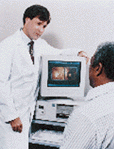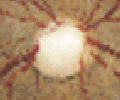Low-pressure glaucoma: A diagnosis of exclusion
 --- Christopher J. Quinn, OD
--- Christopher J. Quinn, OD
NEW YORK—Clinicians who successfully diagnose and manage low-pressure glaucoma must also be adept at ruling out other causes of optic neuropathy, said Christopher J. Quinn, OD.
"The bottom line on low-tension glaucoma is that it really is a diagnosis of exclusion," said Quinn, director of Omni Eye Services, Iselin, N.J. "You must rule out other causes of optic neuropathy and remember that you typically don't need to achieve the same type of pressure in low-tension glaucoma patients that you do with normal glaucoma patients. Quinn addressed this topic here at International Vision Expo East.
While elevated IOP normally characterizes glaucoma, low-pressure glaucoma patients have an IOP consistently below 22 mm Hg and will show glaucomatous optic disk or visual field changes.
When treating any glaucoma, Quinn advocates aggressive therapy to preserve optic nerve function. "The problem is that this disease progresses so slowly it is difficult to appreciate that progression," he said. "You are better off being aggressive initially, rather than sitting back and waiting for obvious signs of progressive optic nerve damage."
Aggressive treatment is more difficult in low-pressure glaucoma patients; therefore, the options are limited and the patients must be followed diligently. "The pressure's already low, so it's difficult to decide how much lower you need to go," Quinn said. "In regular glaucoma we can see a dramatic decrease in IOP with treatment because the pressure's already high."
Rule out diurnal pressure variation
Before low-pressure glaucoma is diagnosed, other causes of optic neuropathy must be ruled out, Quinn said, starting with diurnal variation in pressure. "You might check these patients at 3 in the afternoon and their pressure is 15 every time; but if you check them at 9 in the morning and it's 26, suddenly it's not low-tension glaucoma," he said.
Optometrists also must be aware of any systemic beta-blockers or systemic carbonic anhydrase inhibitors a patient may be taking, because both medications tend to lower pressure.
Other exclusions, Quinn said, include making sure patients do not suffer from a compressive optic neuropathy due to a tumor or ischemic optic neuropathy associated with temporal arteritis. Some patients will have intermittent angle-closure glaucoma—also termed subacute angle-closure glaucoma—and should not be treated for low-pressure glaucoma when they periodically have pressure spikes into their 60s. "That's why gonioscopy is important," Quinn said.
Target pressure key to treatment
 --- Scrutinize carefully: An optic nerve showing advanced glaucomatous damage such as this may not always be accompanied by high IOP.
--- Scrutinize carefully: An optic nerve showing advanced glaucomatous damage such as this may not always be accompanied by high IOP.
Once low-pressure glaucoma is diagnosed, Quinn said the clinician must set a target IOP to guide therapy. "My formula for setting this target pressure is to attempt to reduce the pressure by the percentage the pressure is," he said. "For example, if the pressure is 30 and you decide to treat, then perhaps a good starting point is to try to reduce the pressure 30%."
Without a target IOP, he said, the clinician might accept an IOP that's not ideal for the low-pressure patient. "You don't want to accept a marginal pressure, do nothing and then see the patient in 4 months," Quinn said. "That's why target IOP is important."
A target IOP can be modified on an individual basis, he said, taking into account the extent of visual field loss, optic nerve damage and the patient's risk factors.
After gathering this additional information, the clinician may be satisfied with an IOP slightly above the target pressure or decide that an additional reduction is necessary, "depending on the whole picture of the patient."
Quinn acknowledges this formula "sort of falls apart" when the patient has a pressure of 15, in which case the clinician may have to be satisfied with a reduction in pressure to only 12 or 13.
"What I like to do in low-tension glaucoma patients is try to reduce their pressure whatever amount I can, however I can, that is reasonable in terms of side effects and without adding too many medications," he said.
Unfortunately, Quinn said, clinicians who diagnose low-pressure glaucoma still face difficult decisions when it comes to therapy. "This area is somewhat controversial now because some people feel that some of the traditional glaucoma drugs may actually reduce circulation in the optic nerve and may not be the best choice in patients who have low-tension glaucoma," he said.
Treatment options
For instance, Quinn said, some researchers have suggested that the best initial treatment is the selective beta-blocker betaxolol (Betoptic, Alcon) because it tends not to affect blood flow. "If you subscribe to the theory that glaucoma is a vascular condition, you may need to use caution or consider the research that is looking at that question right now," he said. "The issue of optic nerve head blood flow is not yet resolved."
Clinicians will probably want to avoid prescribing an epinephrine-like drug in a low-pressure glaucoma patient because there is evidence that these drugs reduce blood flow in the optic nerve bed. Topical carbonic anhydrase inhibitors do not affect blood flow, Quinn noted, and are good initial therapy choices.
"You may start treatment with betaxolol and then add dorzolamide (Trusopt, Merck) secondarily," Quinn continued. A nonselective beta-blocker with once-daily dosing, timolol maleate ophthalmic gel (Timoptic XE, Merck) is another option that can help keep low-pressure glaucoma patients compliant.
Patients with congestive heart failure or bradycardia are contraindicated for beta-blockers, Quinn said, while noting there are no significant complications associated with topical carbonic anhydrase inhibitors.
The final step in successfully treating low-pressure glaucoma patients is constant reinforcement, Quinn said. "It's critical to keep educating these patients," he said. "They don't have a problem with the way their eyes feel or the way they see, and you've got to reinforce the importance of taking their drops and the potential complications if they don't."
Clinicians who can achieve a target pressure in low-pressure glaucoma patients should see the patients every 3 months for follow-up and carefully document the appearance of the optic nerve head.
This documentation can be done with stereodisc photography, but Quinn suggests clinicians perform optic nerve imaging to objectively measure the optic nerve.
"In managing the low-tension glaucoma patient, everything becomes a little more complicated, so you need as much information as you can obtain," he said.
Visual Field Imposters
- Anterior ischemic optic neuropathy
- Optic nerve drusen
- Branch retinal artery occlusion
- Retinal detachment
- Retrobulbar optic neuritis
- Compressive optic nerve lesions
Source: Christopher J. Quinn, OD
Other Possible Causes of Optic Neuropathy
- Diurnal variation
- Vasculitis
- Optic atrophy
- Chronic marijuana use
- Prior hypotensive episodes
- Systemic beta-blocker
- Subacute angle closure
- History of steroid use
- Ocular ischemic syndrome
- Compressive optic neuropathy
Source: Christopher J. Quinn, OD
